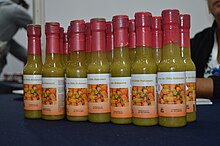Habanero
The habanero heat, flavor, and floral aroma make it a common ingredient in hot sauces and other spicy foods.
The habanero is named after the Cuban city of La Habana, known in English as Havana, because it used to feature heavily in trading there.
[6] Habaneros are an integral part of Yucatecan food, accompanying most dishes, either in natural form or purée or salsa.
[citation needed] The habanero chili was disseminated by Spanish colonists to other areas of the world, to the point that 18th-century taxonomists mistook China for its place of origin and called it Capsicum chinense ("the Chinese pepper").
Both varieties average around the same level of pungency, but the actual degree varies greatly from one fruit to another according to genetics, growing methods, climate, and plant stress.
The heat of the habanero does not immediately take effect, but sets in over a period of a few minutes and lasts up to an hour in the mouth.
Like all peppers, the habanero does well in an area with good morning sun and in soil with a pH level around 5 to 6 (slightly acidic).
[citation needed] Several growers have attempted to selectively breed habanero plants to produce hotter, heavier, and larger peppers.
[12] Breeder Michael Mazourek used a mutation discovered by the Chile Pepper Institute to create a heatless version labeled the 'Habanada' bred in 2007 and released in 2014.

